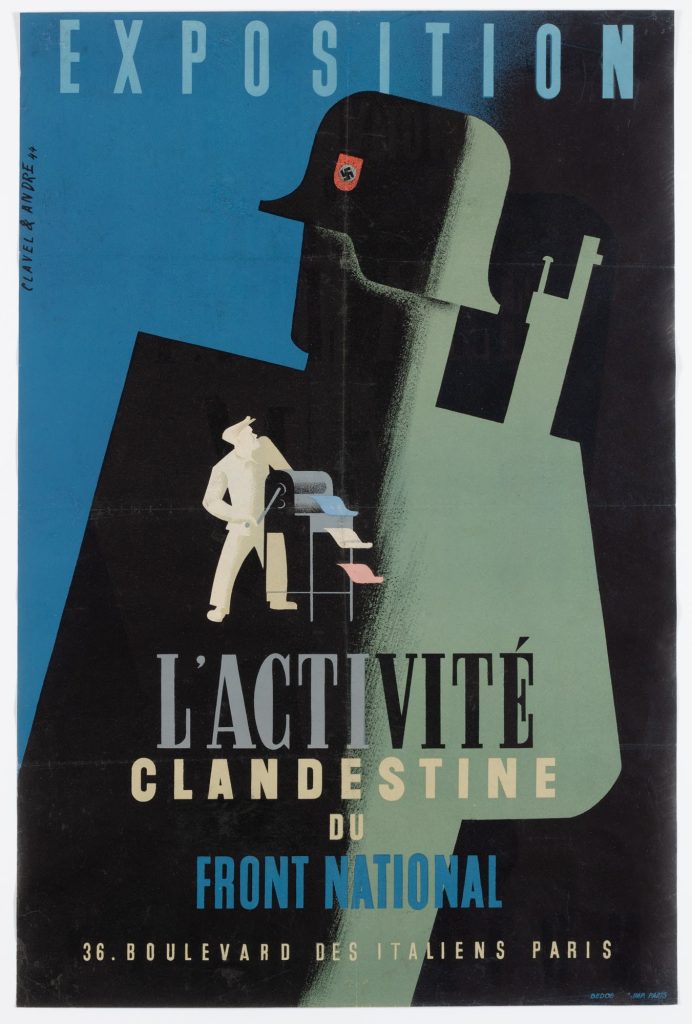Selections from the Tetlie Collection of World War II Propaganda Posters
Introduction
These posters are a selection from the Tetlie Collection of World War II Propaganda Posters, which is currently in the custody of the Flaten Art Museum and will be permanently housed with Rolvaag Special Collections at St. Olaf College.
Unlike most collections of World War II posters related to Nazi Germany, the Tetlie posters focus on Nazi-occupied Europe rather than the Third Reich. They include over a hundred examples from France, Belgium, Luxembourg, Netherlands, Soviet Union, and the Channel Islands, gathered immediately after the end of World War II. These posters direct attention to the intersection of Nazi policy and the realities of daily life under occupation. The seven posters in the current exhibition target occupied France, and they highlight Nazi efforts to radicalize racial ideology, foster distrust of the Allies, and rally occupied populations to the Nazi war effort.
This project was made possible in part by the Institute of Museum and Library Services (MA-30-19-0637). The views expressed in this exhibition do not necessarily represent those of the Institute of Museum and Library Services.
Teaching Guide
This teaching guide was developed to complement the selected posters in this exhibition, and provide opportunities for classroom reflection. It can also be used to study other posters in the Tetlie Collection of World War II Propaganda Posters.
The teaching guide highlights questions to prompt critical thinking and engagement with the posters in the Tetlie Collection. By focusing on visual analysis, investigation of the antisemitic content, consideration of the material qualities of the posters, and how propaganda works, viewers can complete a well-rounded study of the posters and their impact.
HISTORICAL CONTEXT
NAZI–OCCUPIED EUROPE AT THE HEIGHT OF GERMAN EXPANSION, 1941–42
The Nazi invasion of Poland that began World War II in 1939 was followed by a brief period of comparably minor hostilities known derisively as the “Phony War.” German invasion of France, Belgium, the Netherlands, and Luxembourg in May 1940 resumed full-scale fighting in a campaign known as the Blitzkrieg, literally, the “Lightning War.”
In just six weeks, France and its continental allies were defeated, leaving Great Britain to stand alone against a sustained Nazi bombing campaign on London (the “Battle for Britain”). The Blitzkrieg’s success meant that by 1941 Nazi Germany had overrun most of Western and Central Europe, an area known as “Fortress Europe,” that was seemingly impenetrable by Allied forces. “Operation Barbarossa,” which launched the Nazi invasion of the Soviet Union in June 1941, extended the German army’s reach farther eastward until its defeat in the battle of Stalingrad (August 1942–February 1943).
Fortress Europe was an undeniable military advantage for the Nazis, but it was also a significant administrative challenge. Occupation authorities worked to control millions of people and acres of territory while fighting a war that continued to expand and devour more and more resources.
At the same time, Nazis were carrying out the genocide of two-thirds of Europe’s Jewish population through mass shootings, gas chambers, torture, and violent riots, to end the so-called “Jewish problem.” From the Nazi perspective, all these exploits competed for administrative, military, and technical resources. Getting popular buy-in from occupied countries, through propaganda and other means, was essential for making the Holocaust possible.
Recruiting Laborers
The Nazis relied on laborers from occupied nations to help sustain the war effort, and posters aided their recruitment efforts. Initially the French government negotiated with Germany to establish a voluntary program. The Relève incentivized civilian volunteers with the promise of releasing three French prisoners of war from Germany for each individual who enlisted. By late 1942 the Germans demanded a compulsory labor program. Under intense pressure, the French government began the Service du travail obligatoire (STO) mandate in early 1943, which required both French men and women to work for the war effort in Germany.
While the trio of posters Votre Famille…, Ouvrier!…, and Loin Des Tiens… represent three distinct phases of Nazi labor recruitment in France, they all capitalize on traditional gender norms. The men are depicted as large and powerful providers and protectors, whereas the women are generally small (or nonexistent) and focused exclusively on the children they embrace. Personal and patriotic expectations are entangled, tapping deeply entrenched cultural values in service of the Nazi agenda.
POSTERS
This site was generously produced and designed by the DiSCO (Digital Scholarship Center) at St. Olaf College, with a special thanks to Omar Al-Taie ’24, Khan Henderson ’22, and Sasha Kazhaskaya ’22.







